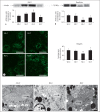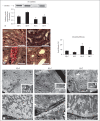Angiotensin II activation of mTOR results in tubulointerstitial fibrosis through loss of N-cadherin
- PMID: 21720156
- PMCID: PMC3130895
- DOI: 10.1159/000329327
Angiotensin II activation of mTOR results in tubulointerstitial fibrosis through loss of N-cadherin
Abstract
Background/aims: Angiotensin (Ang) II contributes to tubulointerstitial fibrosis. Recent data highlight mammalian target of rapamycin (mTOR)/S6 kinase 1 (S6K1) signaling in tubulointerstitial fibrosis; however, the mechanisms remain unclear. Thereby, we investigated the role of Ang II on mTOR/S6K1-dependent proximal tubule (PT) injury, remodeling, and fibrosis.
Methods: We utilized young transgenic Ren2 rats (R2-T) and Sprague-Dawley rats (SD-T) treated with the Ang type 1 receptor (AT(1)R) blocker telmisartan (2 mg · kg(-1) · day(-1)) or vehicle (R2-C; SD-C) for 3 weeks to examine PT structure and function.
Results: Ren2 rats displayed increased systolic blood pressure, proteinuria and increased PT oxidant stress and remodeling. There were parallel increases in kidney injury molecule-1 and reductions in neprilysin and megalin with associated ultrastructural findings of decreased clathrin-coated pits, endosomes, and vacuoles. Ren2 rats displayed increased Serine(2448) phosphorylation of mTOR and downstream S6K1, in concert with ultrastructural basement membrane thickening, tubulointerstitial fibrosis and loss of the adhesion molecule N-cadherin. Telmisartan treatment attenuated proteinuria as well as the biochemical and tubulointerstitial structural abnormalities seen in the Ren2 rats.
Conclusions: Our observations suggest that Ang II activation of the AT(1)R contributes to PT brush border injury and remodeling, in part, due to enhanced mTOR/S6K1 signaling which promotes tubulointerstitial fibrosis through loss of N-cadherin.
Copyright © 2011 S. Karger AG, Basel.
Figures





Similar articles
-
Mineralocorticoid receptor-dependent proximal tubule injury is mediated by a redox-sensitive mTOR/S6K1 pathway.Am J Nephrol. 2012;35(1):90-100. doi: 10.1159/000335079. Epub 2011 Dec 24. Am J Nephrol. 2012. PMID: 22205374 Free PMC article.
-
Nebivolol attenuates maladaptive proximal tubule remodeling in transgenic rats.Am J Nephrol. 2010;31(3):262-72. doi: 10.1159/000278757. Epub 2010 Jan 25. Am J Nephrol. 2010. PMID: 20110666 Free PMC article.
-
Combination of direct renin inhibition with angiotensin type 1 receptor blockade improves aldosterone but does not improve kidney injury in the transgenic Ren2 rat.Regul Pept. 2012 Jun 10;176(1-3):36-44. doi: 10.1016/j.regpep.2012.03.002. Epub 2012 Mar 29. Regul Pept. 2012. PMID: 22465166 Free PMC article.
-
Comparative effect of direct renin inhibition and AT1R blockade on glomerular filtration barrier injury in the transgenic Ren2 rat.Am J Physiol Renal Physiol. 2010 Mar;298(3):F655-61. doi: 10.1152/ajprenal.00373.2009. Epub 2009 Dec 9. Am J Physiol Renal Physiol. 2010. PMID: 20007350 Free PMC article.
-
Angiotensin II-mediated oxidative stress promotes myocardial tissue remodeling in the transgenic (mRen2) 27 Ren2 rat.Am J Physiol Endocrinol Metab. 2007 Jul;293(1):E355-63. doi: 10.1152/ajpendo.00632.2006. Epub 2007 Apr 17. Am J Physiol Endocrinol Metab. 2007. PMID: 17440033
Cited by
-
Mineralocorticoid receptor-dependent proximal tubule injury is mediated by a redox-sensitive mTOR/S6K1 pathway.Am J Nephrol. 2012;35(1):90-100. doi: 10.1159/000335079. Epub 2011 Dec 24. Am J Nephrol. 2012. PMID: 22205374 Free PMC article.
-
Participation of the SMAD2/3 signalling pathway in the down regulation of megalin/LRP2 by transforming growth factor beta (TGF-ß1).PLoS One. 2019 May 23;14(5):e0213127. doi: 10.1371/journal.pone.0213127. eCollection 2019. PLoS One. 2019. PMID: 31120873 Free PMC article.
-
Bicalutamide Elicits Renal Damage by Causing Mitochondrial Dysfunction via ROS Damage and Upregulation of HIF-1.Int J Mol Sci. 2020 May 11;21(9):3400. doi: 10.3390/ijms21093400. Int J Mol Sci. 2020. PMID: 32403414 Free PMC article.
-
NCI's provocative questions on cancer: some answers to ignite discussion.Oncotarget. 2011 Dec;2(12):1352-67. doi: 10.18632/oncotarget.432. Oncotarget. 2011. PMID: 22267462 Free PMC article.
-
mTOR Overactivation and Compromised Autophagy in the Pathogenesis of Pulmonary Fibrosis.PLoS One. 2015 Sep 18;10(9):e0138625. doi: 10.1371/journal.pone.0138625. eCollection 2015. PLoS One. 2015. PMID: 26382847 Free PMC article.
References
-
- Eddy AA. Progression in chronic kidney disease. Adv Chronic Kidney Dis. 2005;12:353–365. - PubMed
-
- Rodríguez-Iturbe B, García García G. The role of tubulointerstitial inflammation in the progression of chronic renal failure. Nephron Clin Pract. 2010;116:c81–c88. - PubMed
-
- Fujii H, Kono K, Nakai K, Goto S, Komaba H, Hamada Y, Shinohara M, Kitazawa R, Kitazawa S, Fukagawa M. Oxidative and nitrosative stress and progression of diabetic nephropathy in type 2 diabetes. Am J Nephrol. 2010;31:342–352. - PubMed
-
- Okada H, Kalluri R. Cellular and molecular pathways that lead to progression and regression of renal fibrogenesis. Curr Mol Med. 2005;5:467–474. - PubMed
-
- Sowers JR. Metabolic risk factors and renal disease. Kidney Int. 2007;71:719–720. - PubMed
Publication types
MeSH terms
Substances
Grants and funding
LinkOut - more resources
Full Text Sources
Molecular Biology Databases
Research Materials
Miscellaneous

